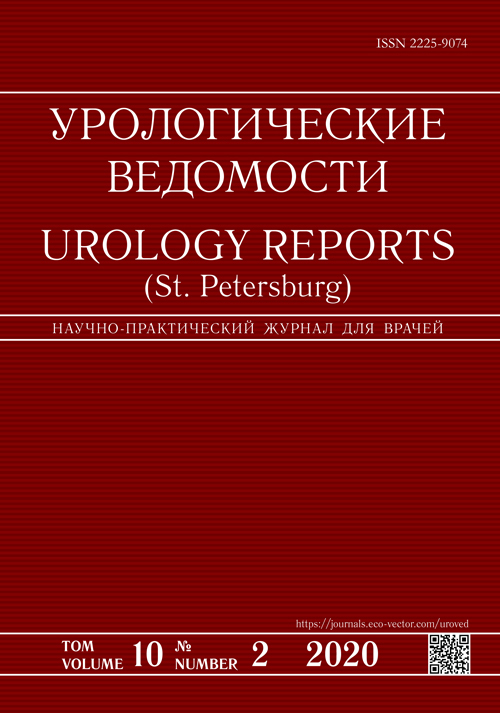不同化学成分的泌尿结石取决于尿量的水平的发生
- 作者: Prosiannikov M.Y.1, Anokhin N.V1, Golovanov S.A.1, Konstantinova O.V1, Sivkov A.V.1, Apolihin O.I.1
-
隶属关系:
- Scientific Research Institute of Urology and Interventional Radiology named after N.A. Lopatkin - Branch of the National Medical Research Radiological Centre of the Ministry of Health of Russian Federation
- 期: 卷 10, 编号 2 (2020)
- 页面: 107-113
- 栏目: Original articles
- URL: https://journal-vniispk.ru/uroved/article/view/19223
- DOI: https://doi.org/10.17816/uroved102107-113
- ID: 19223
如何引用文章
详细
简介根据现代概念,尿石症发病机制的关键环节之一是结石代谢障碍。研究多种因素对尿石症患者的复杂影响是现代科学研究尿石症发病机制的基础。本文研究了不同尿量中不同化学成分的尿结石发病率。
材料和方法。我们分析了708名尿石病患者(303名男性和405名女性)的数据。在工作过程中,对血液和日常尿液的生化分析结果,尿液中结石的化学成分分析进行了研究。为评估不同程度尿尿时不同化学成分结石的发生情况,将尿量按10个间隔排列:从0.4至14.8 mmol/天。
结果。当尿液中尿酸水平升高时,由尿酸构成的结石的发生频率也增加。当尿量增加到3.11 mmol/天以上时,草酸钙结石的发生有持续增加的趋势。与此相反,随着尿液中尿酸排泄量在3.11 mmol/天以上增加,出现含碳尿石症的发病率和鸟粪石结石的患病率下降。尿酸和草酸钙结石是最常见的高水平的尿酸排泄。
结论。监测尿液中尿酸的排泄水平对草酸钙和尿酸尿石症至关重要。
作者简介
Michail Prosiannikov
Scientific Research Institute of Urology and Interventional Radiology named after N.A. Lopatkin - Branch of the National Medical Research Radiological Centre of the Ministry of Health of Russian Federation
Email: prosyannikov@gmail.com
MD, PhD, Head, Department of Urolithiasis
俄罗斯联邦, MoscowNikolay Anokhin
Scientific Research Institute of Urology and Interventional Radiology named after N.A. Lopatkin - Branch of the National Medical Research Radiological Centre of the Ministry of Health of Russian Federation
编辑信件的主要联系方式.
Email: anokhinnikolay@yandex.ru
ORCID iD: 0000-0002-4341-4276
Researcher
俄罗斯联邦, Moscow, RussiaSergey Golovanov
Scientific Research Institute of Urology and Interventional Radiology named after N.A. Lopatkin - Branch of the National Medical Research Radiological Centre of the Ministry of Health of Russian Federation
Email: sergeygol124@mail.ru
MD, PhD, Dr Med Sci, Professor, Head, Scientific Laboratory Department
俄罗斯联邦, MoscowOlga Konstantinova
Scientific Research Institute of Urology and Interventional Radiology named after N.A. Lopatkin - Branch of the National Medical Research Radiological Centre of the Ministry of Health of Russian Federation
Email: konstant-ov@yandex.ru
doctor of medical science, Chief researcher
俄罗斯联邦, Moscow, RussiaAndrey Sivkov
Scientific Research Institute of Urology and Interventional Radiology named after N.A. Lopatkin - Branch of the National Medical Research Radiological Centre of the Ministry of Health of Russian Federation
Email: uroinfo@yandex.ru
candidate of medical science, deputy director
俄罗斯联邦, Moscow, RussiaOleg Apolihin
Scientific Research Institute of Urology and Interventional Radiology named after N.A. Lopatkin - Branch of the National Medical Research Radiological Centre of the Ministry of Health of Russian Federation
Email: apolikhin.oleg@gmail.com
Corresponding Member of Russian Academy of Sciences, doctor of medical science, professor
俄罗斯联邦, Moscow参考
- Константинова О.В. Прогнозирование и принципы профилактики мочекаменной болезни: Автореф. дис. … докт. мед. наук. – М., 1999. – 39 с. [Konstantinova OV. Prognozirovaniye i printsipy profilaktiki mochekamennoy bolezni. [dissertation abstract] Moscow; 1999. 39 р. (In Russ.)]. Доступно по: https://search.rsl.ru/ru/record/01000223000. Ссылка активна на 10.02.2020.
- Голованов С.А. Клинико-биохимические и физико-химические критерии течения и прогноза мочекаменной болезни: Дис. … докт. мед. наук. – М., 2003. – 314 с. [Golovanov SA. Kliniko-biokhimicheskiye i fiziko-khimicheskiye kriterii techeniya i prognoza mochekamennoy bolezni. [dissertation] Moscow; 2003. 314 р. (In Russ.)]. Доступно по: https://search.rsl.ru/ru/record/01004311319. Ссылка активна на 10.02.2020.
- Reichard C, Gill BC, Sarkissian C, et al. 100 % uric acid stone formers: what makes them different? Urology. 2015;85(2): 296-298. https://doi.org/10.1016/j.urology.2014.10.029.
- Trinchieri A, Montanari E. Biochemical and dietary factors of uric acid stone formation. Urolithiasis. 2018;46(2):167-172. https://doi.org/10.1007/s00240-017-0965-2.
- Torricelli FC, De S, Liu X, et al. Can 24-hour urine stone risk profiles predict urinary stone composition? J Endourol. 2014;28(6):735-738. https://doi.org/10.1089/end.2013. 0769.
- Cicerello E. Uric acid nephrolithiasis: an update. Urologia. 2018;85(3):93-98. https://doi.org/10.1177/0391560318766823.
- Moe OW, Xu LH. Hyperuricosuric calcium urolithiasis. J Nephrol. 2018;31(2):189-196. https://doi.org/10.1007/s40620-018-0469-3.
- Hirasaki S, Koide N, Fujita K, et al. Two cases of renal hypouricemia with nephrolithiasis. Intern Med. 1997;36(3):201-205. https://doi.org/10.2169/internalmedicine.36.201.
- Kenny JE, Goldfarb DS. Update on the pathophysiology and management of uric acid renal stones. Curr Rheumatol Rep. 2010;12(2):125-129. https://doi.org/10.1007/s11926-010-0089-y.
- Moe OW, Abate N, Sakhaee K. Pathophysiology of uric acid nephrolithiasis. Endocrinol Metab Clin North Am. 2002;31(4):895-914. https://doi.org/10.1016/s0889-8529(02)00032-4.
- Lonsdale K. Epitaxy as a growth factor in urinary calculi and gallstones. Nature. 1968;217(5123):56-58. https://doi.org/10.1038/217056a0.
- Coe FL, Lawton RL, Goldstein RB, Tembe V. Sodium urate accelerates precipitation of calcium oxalate in vitro. Proc Soc Exp Biol Med. 1975;149(4):926-9. https://doi.org/10.3181/00379727-149-38928.
- Pak CY, Arnold LH. Heterogeneous nucleation of calcium oxalate by seeds of monosodium urate. Proc Soc Exp Biol Med. 1975;149(4): 930-932. https://doi.org/10.3181/00379727-149-38929.
- Pak CY, Barilla DE, Holt K, et al. Effect of oral purine load and allopurinol on the crystallization of calcium salts in urine of patients with hyperuricosuric calcium urolithiasis. Am J Med. 1978;65(4): 593-599. https://doi.org/10.1016/0002-9343(78)90846-x.
- Robertson WG. Physical chemical aspects of calcium stone-formation in the urinary tract. In: Fleisch H, Robertson WG, Smith LH, Vahlensieck W. Urolithiasis Research. New York: Plenum Press; 1976. Р. 25-39. https://doi.org/10.1007/978-1-4613-4295-3_2.
- Donaldson JF, Ruhayel Y, Skolarikos A, et al. Treatment of bladder stones in adults and children: a systematic review and meta-analysis on behalf of the european association of urology urolithiasis guideline panel. Eur Urol. 2019;76(3):352-367. https://doi.org/10.1016/j.eururo.2019.06.018.
- Englert KM, McAteer JA, Lingeman JE, Williams JC, Jr. High carbonate level of apatite in kidney stones underlines infection, but is it predictive? Urolithiasis. 2013;41(5):389-394. https://doi.org/10.1007/s00240-013-0591-6.
- Frassetto L, Kohlstadt I. Treatment and prevention of kidney stones: an update. Am Fam Physician. 2011;84(11):1234-1242.
- Hall PM. Nephrolithiasis: treatment, causes, and prevention. Cleve Clin J Med. 2009;76(10):583-591. https://doi.org/10.3949/ccjm.76a.09043.
- Cicerello E, Mangano M, Cova GD, et al. Metabolic evaluation in patients with infected nephrolithiasis: is it necessary? Arch Ital Urol Androl. 2016;88(3):208-211. https://doi.org/10.4081/aiua.2016.3.208.
- Iqbal MW, Shin RH, Youssef RF, et al. Should metabolic evaluation be performed in patients with struvite stones? Urolithiasis. 2017;45(2):185-192. https://doi.org/10.1007/s00240-016-0893-6.
补充文件







